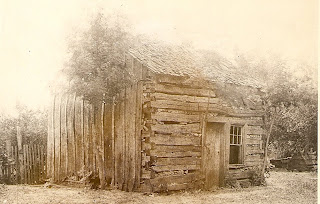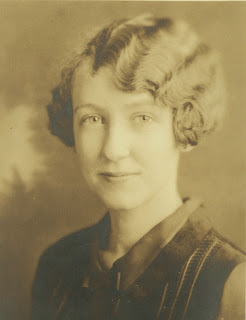 This item is as written by Helen Rogler and found in one of her scrapbooks.
This item is as written by Helen Rogler and found in one of her scrapbooks.By Helen Rogler, September 8, 1966
This story is being written by Helen Rogler from information given to her by Henry Rogler in 1964, and Adeline Beedle in 1966. According to Mrs. Beedle, two brothers had come from south Russia. One settled in Berlin, and became an iron master; the other became a farmer near Asch, Austria-Hungary, in the small town of Nassengrub. He was a good carpenter, and had a shop in Asch. The family considered themselves Czechoslovakians, here say has it that they had formerly lived in Sudaten.
Johann, the farmer had ten children, four died there. They were a very religious family, Lutherans or Hussite's. Because of religious persecution and because most young men were required to go into the army the family decided to leave. They came down the Rhine to Hamburg, and caught a sailing ship to America, landing in New Orleans. On the way over, Johann, the father, was very ill, but here say has it that whiskey saved his life for he had become very ill when a bad storm had forced the closure of all windows in the steerage.
Johann and Joanna Catharine, his wife, and six children, two boys and four girls, came up the Mississippi River to the mouth of the Missouri on to Council Bluffs. They stayed there a year, and Charles worked in Ohio, at Sandusky at skinning cattle in a tannery. They had sold their 10 acres of land at Nassengrub and had no money worries. Then he came back to Council Bluffs and joined a friend Henry Brandley.
They walked to Kansas and down the dry bed of the Cottonwood River to select home sites. Bazaar was a small town of 6 houses at the time, and Chase County did not exist.
__________________
Charles settled on a home site about 1 1/2 miles north of the present town of Matfield Green. After a year, he went back to Iowa by horseback and brought all his family to Kansas except the brother John. The settled at the present home of Henry Rogler, in a cabin.
Charles bound out Lawrence Rogler, his brother, to a family named Mitchell, who lived on what was the Albert Rogler home later. They were very religious, and not too kind to him, but after a year, he moved back to Jim Rogler's, Jim had lived with Charles until that time. But, he bought 80 acres of he 160 homestead of the father Johann (or John) for $3 an acre. This was the present Carl Beedle place, just north of Matfield.
Lawrence bought the other 80 acres about a mile east of Matfield Green. Charles continued to live on the present Henry Rogler homestead, and being an astute business man had acquired more land to add to his original 160 acres.
Lawrence was guardian of the family for several years and was paid $500 a year, if memory serves Mrs. Beedle right. Later, Albert became guardian, and Henry Brandley was administrator. Charles Rogler married Mary Satchel from near El Dorado in 1867. Charles had about $1000 worth of insurance in the Woodman organization which put Emma, Kate, Albert, Henry, and Jennie thru two or three years of school. Henry finished Kansas State College of Agriculture in 1898, and Albert took a business course. Kate and Emma went to Emporia State College for a while. Charles Rogler died of pneumonia after getting wet in a storm in 1888, and left about $8000 in cash which Albert, as administrator invested in more land. He purchased 800 acres west of the old Naylor place for $4 an acre, and 400 acres east of Southfork for $3.75, and also 160 acres south of Crocker Stock and the old Largent place. He lived there for a number of years until his children were high school age, then moved into Cottonwood Falls.
Albert was still administrator when Henry Rogler graduated from college and Henry took over the job of looking after the farm and 5 hired men who worked for him for 5 years at $1 a day. George Nieles lived in the old John Watchous house on Coyne Creek, John Wallace had a house at the present Matfield stockyards. Another house was located on the 16 acres east of Wayne Rogler's present place.
George Jackson lived in the house later taken over by Charles Broiles, east of Southfork and Henry Rogler's. Albert lived with Jim Rogler until he acquired his own place in about 1900. The family had about 3000 acres by this time divided in 1902. Henry Rogler had rented the 80 acres at the present home site, and married Maud Sauble in 1901.
The next year, he worked out a division of the land among the children. He divided it so each would get some bottom land and some pasture. Albert's land was the farthest north. He had 160 acres west of the road. Emma's land started with the Crocker Creek bridge and she had the present home place. She had the north one half of the southeast quarter of section 31, of 60 acres, plus about 200 acres of pasture west and some land north of Matfield, about 80 acres of the SE quarter of section 11.
Jennie came next, just south of Emma's, getting the south half of the SE quarter of section 31, township 21. She was also given about 800 acres of pasture west of the road. Henry took the next strip south, near the present Reynold Peck home, plus 480 acres of pasture east of the homestead called the old Broiles pasture, later. He had purchased 160 acres himself on Stakebake Creek, so he had about 900 acres of his own by 1900. After this division, they had a sale, and all the cattle and farm implements were sold. The land was paid for except for a mortgage on Albert Rogler's place, since he had acquired twice as much land as the others in this division. The money which Kate, Emma, and Henry had spent in college was deducted from their inheritance.
The wife of Charles Rogler had to be placed in a mental institution, and she was given an undivided mortgage, or about one half interest, about $4000 from each child. This was supplied to support her, but Henry Rogler supported her almost solely for years.
Henry purchased Emma's place for $8500, half of which went to his wife Maud. He purchased the pasture land of 200 acres, and the bottom land, which is now about 900 acres. His next purchase was 120 acres of Kate's land for $6500 cash, but he did not buy the 1000 acres of pasture land although it was offered to him for $5 and acre at the time. He rented this for many years from Kate, then later the children, Catharine and Kate.
His next purchase was 160 acres from Jennie. Other land which he added was 160 acres from George Lawrence at $10 an acre. Then he bought 400 acres from Albert in 1920 for $4000. He bought 80 acres on Stakebake for $4 an acre and 240 from someone else for $8 an acre. He also bought 600 acres of the Panke land for $20,000 in 1922. The most he ever owned was 2800 acres and though he had many mortgages, which he repaid, he never mortgaged the home place.
In 1956, he sold 1357 acres to his son, Wayne Rogler, and the money was divided among the other 3 children, Helen, Irene Palenske, and George Rogler, each receiving $19,334. This left about 800 acres of farm and pasture. During the depression in the 30s, Henry took a mortgage on Albert Rogler's land and gave Maud, his wife, a deed to her section of land. She gave some of the cash to her children at the time.
---Lynne
Next up: Helen attends Kansas State Agriculutural College








